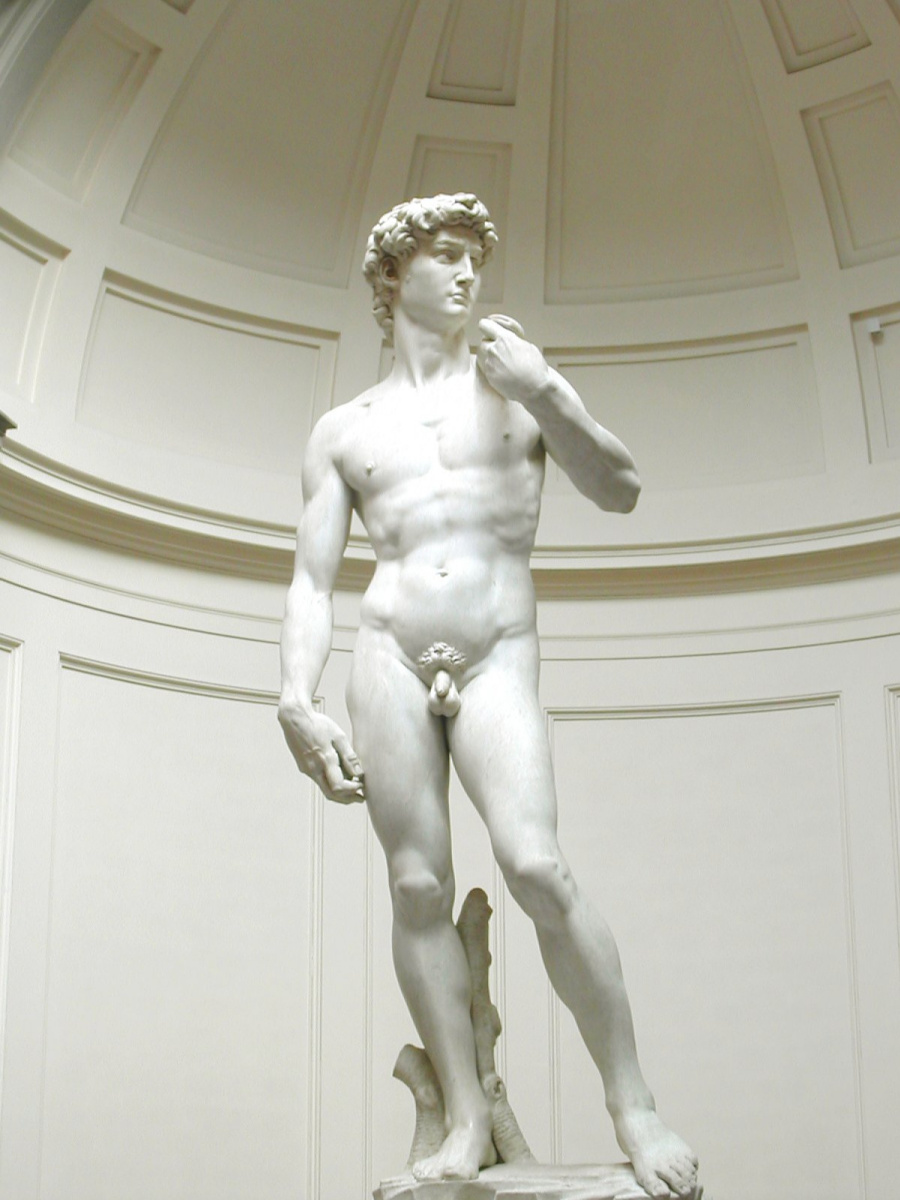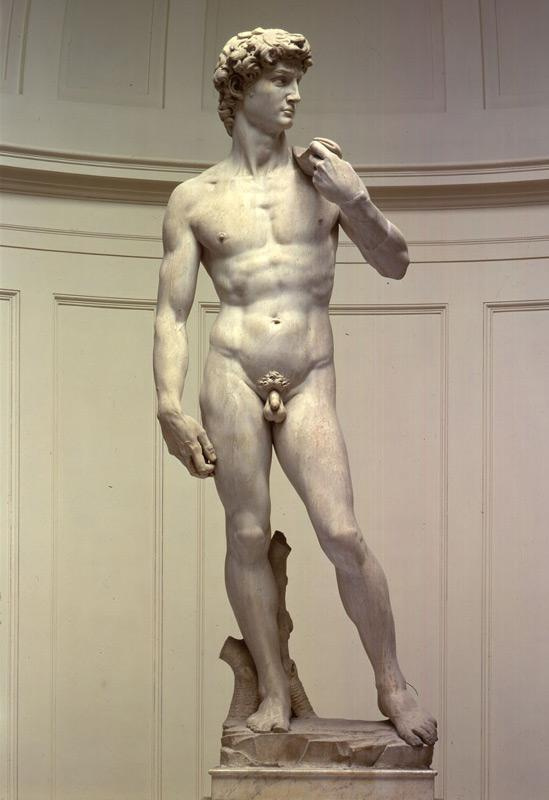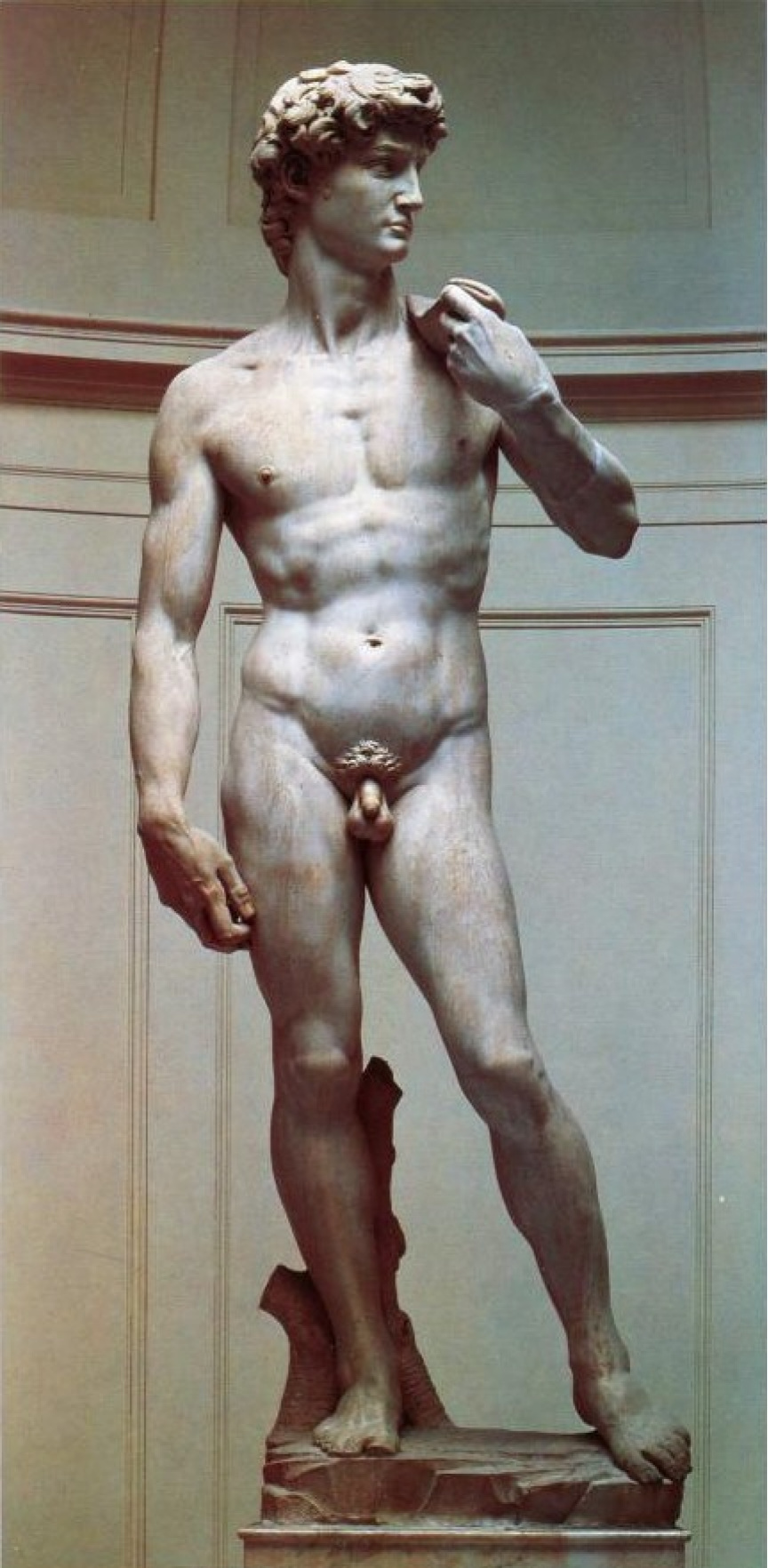log in
Enter site
Login to use Arthive functionality to the maximum
David
Michelangelo Buonarroti • Sculpture, 1504, 517 cm
Description of the artwork «David»
The Statue of David is a universally recognized symbol of the Renaissance and probably the most famous sculpture in the world. Giorgio Vasari claimed that she "took away the glory of all statues, modern and antique, Greek and Roman." Over the past five centuries since the creation of David, things have not changed much: the Michelangelian David is still perceived as a standard of a beautiful body and strong spirit. Here are some interesting facts about the statue.
A defective piece of marble was used to make the most perfect body in history.
Michelangelo began work on David in 1502, and a marble block, which he got for work, lay on the courtyard of one of the Florentine churches since 1464. Almost 40 years ago, other sculptors took up it - whether the famous Agostino di Duccio, or the unknown Bartolomemeo di Pierrot. Neither one nor the other for some reason could not finish the job. Later, many other sculptors, even Leonardo da Vinci, also a native of Florence, also offered to make something worthwhile from the same marble. According to legend, he refused, citing the fact that the marble is already honed by its predecessors and is not suitable for a masterpiece. And that's why Michelangelo agreed. He disliked the arrogant Leonardo and really wanted to surpass him. In a certain sense, Michelangelo succeeded: spoiled marble turned into a great sculpture, although traces of someone else's incisor are visible on David's crown, and on the back, in some places, several millimeters of roundness are missing.
There is even a special name for the emotion that David expresses and which the viewer infects from him - “terribilita”
David’s hands frantically squeeze the stone and sling before a decisive effort - in a second he will tear the sling, and the stone will whistle fly to Goliath. The hero’s eyebrows are menacingly frowned, the nostrils are widened, the eyes are burning, the neck muscles are tense. David is all focus and courage. This recognizable expression is commonly called La terribilita. “This is not so much“ awesome power ”, in the literal sense of the word- explains the largest connoisseur of antiquity, historian Alexei Dzhivelegov, how much is the action of a statue or painting that can bring the viewer out of a calm state and make him experience his impression with some great inner anxiety? ”.
The ruler of Florence believed that David had a too big nose
The student and follower of Michelangelo Giorgio Vasari spoke about this case in his Biographies. The then lifetime gonfalonier of Florence Pedro Soderini came to look at the result of two years of work by Michelangelo. “He really liked the statue, - testifies Vasari, - but when he examined her from different sides, he said: "His nose seems to me to be too big." Noticing that the gonfalonier was at the bottom of the giant and that his vision did not allow him to see for real, Michelangelo climbed the walkways arranged at the height of the shoulders of the statue, and quickly grabbing the cutter and a pinch of marble dust scattered on the bridge boards in his left hand, he became lightly waving the cutter, gradually drop the dust, leaving your nose in the same form. Then, looking down at the gonfalonier, who was standing and looking, he said: "Look now." “Now I like it better,” the gonfalonier answered, “you gave more life.”
In the main square of Florence these days is not the original statue of David, but just a copy
The statue of David was conceived as a symbol of Florence - at that time an independent city-state. The young biblical shepherd David, overcoming the formidable giant Goliath, was supposed to symbolize the political ideal of the republic, which triumphs in the fight against larger and stronger enemies (the Habsburg empire, etc.). Initially, it was planned that David will be located at the city cathedral, but then it was decided to move it to Signoria Square and put it near the Palazzo Vecchio, not far from the city government. The Florentines loved David very much: when in 1527 during the festivities they beat his left hand with a stone, all the marble to the last crumb was reverently picked up and glued into place. In 1873, David was transported under the roof of the museum of the Florentine Academy of Fine Arts, and a marble copy was placed in its old place.
A defective piece of marble was used to make the most perfect body in history.
Michelangelo began work on David in 1502, and a marble block, which he got for work, lay on the courtyard of one of the Florentine churches since 1464. Almost 40 years ago, other sculptors took up it - whether the famous Agostino di Duccio, or the unknown Bartolomemeo di Pierrot. Neither one nor the other for some reason could not finish the job. Later, many other sculptors, even Leonardo da Vinci, also a native of Florence, also offered to make something worthwhile from the same marble. According to legend, he refused, citing the fact that the marble is already honed by its predecessors and is not suitable for a masterpiece. And that's why Michelangelo agreed. He disliked the arrogant Leonardo and really wanted to surpass him. In a certain sense, Michelangelo succeeded: spoiled marble turned into a great sculpture, although traces of someone else's incisor are visible on David's crown, and on the back, in some places, several millimeters of roundness are missing.
There is even a special name for the emotion that David expresses and which the viewer infects from him - “terribilita”
David’s hands frantically squeeze the stone and sling before a decisive effort - in a second he will tear the sling, and the stone will whistle fly to Goliath. The hero’s eyebrows are menacingly frowned, the nostrils are widened, the eyes are burning, the neck muscles are tense. David is all focus and courage. This recognizable expression is commonly called La terribilita. “This is not so much“ awesome power ”, in the literal sense of the word- explains the largest connoisseur of antiquity, historian Alexei Dzhivelegov, how much is the action of a statue or painting that can bring the viewer out of a calm state and make him experience his impression with some great inner anxiety? ”.
The ruler of Florence believed that David had a too big nose
The student and follower of Michelangelo Giorgio Vasari spoke about this case in his Biographies. The then lifetime gonfalonier of Florence Pedro Soderini came to look at the result of two years of work by Michelangelo. “He really liked the statue, - testifies Vasari, - but when he examined her from different sides, he said: "His nose seems to me to be too big." Noticing that the gonfalonier was at the bottom of the giant and that his vision did not allow him to see for real, Michelangelo climbed the walkways arranged at the height of the shoulders of the statue, and quickly grabbing the cutter and a pinch of marble dust scattered on the bridge boards in his left hand, he became lightly waving the cutter, gradually drop the dust, leaving your nose in the same form. Then, looking down at the gonfalonier, who was standing and looking, he said: "Look now." “Now I like it better,” the gonfalonier answered, “you gave more life.”
In the main square of Florence these days is not the original statue of David, but just a copy
The statue of David was conceived as a symbol of Florence - at that time an independent city-state. The young biblical shepherd David, overcoming the formidable giant Goliath, was supposed to symbolize the political ideal of the republic, which triumphs in the fight against larger and stronger enemies (the Habsburg empire, etc.). Initially, it was planned that David will be located at the city cathedral, but then it was decided to move it to Signoria Square and put it near the Palazzo Vecchio, not far from the city government. The Florentines loved David very much: when in 1527 during the festivities they beat his left hand with a stone, all the marble to the last crumb was reverently picked up and glued into place. In 1873, David was transported under the roof of the museum of the Florentine Academy of Fine Arts, and a marble copy was placed in its old place.






